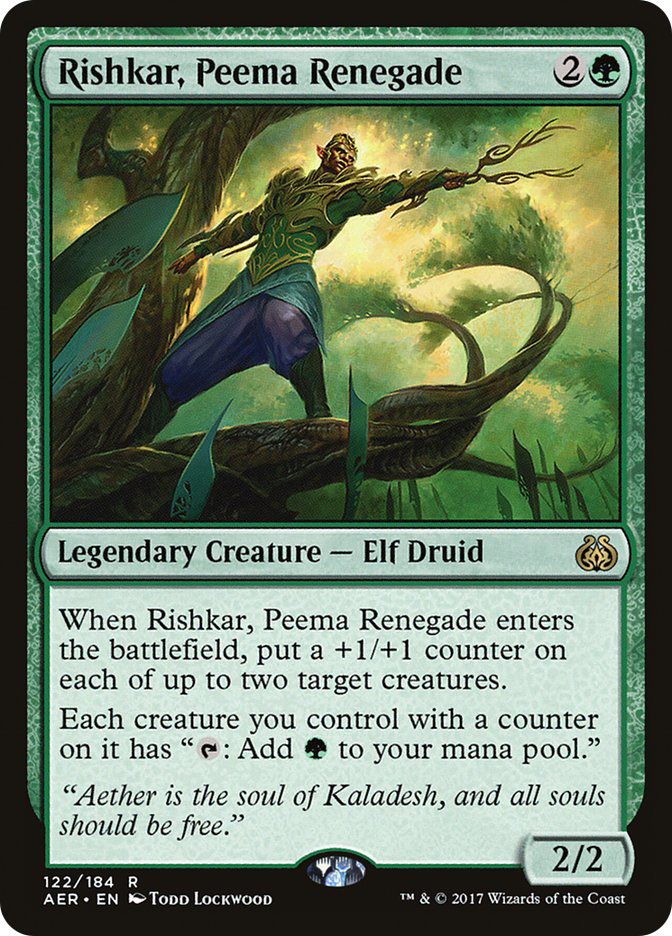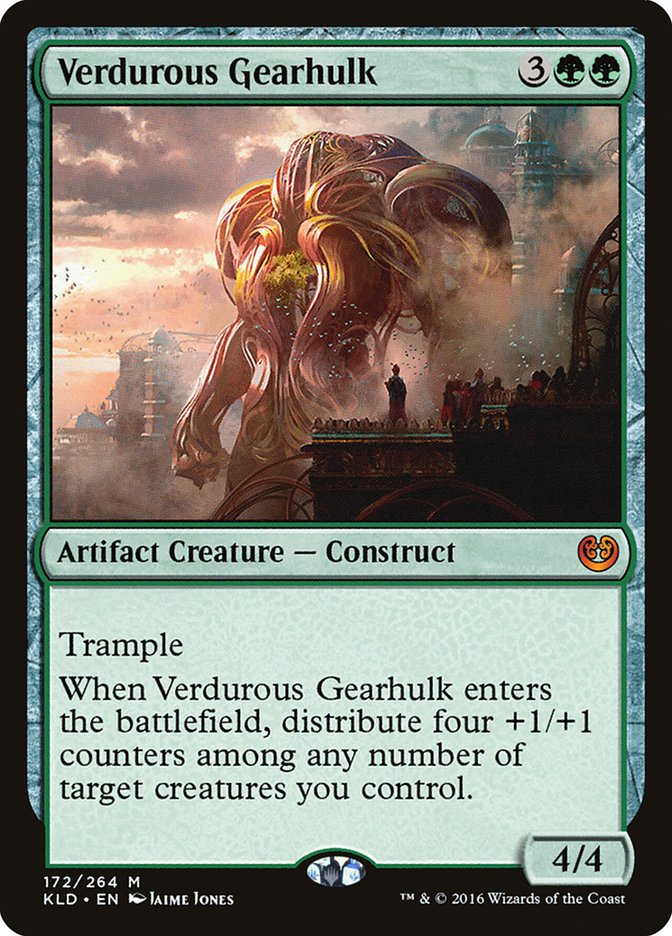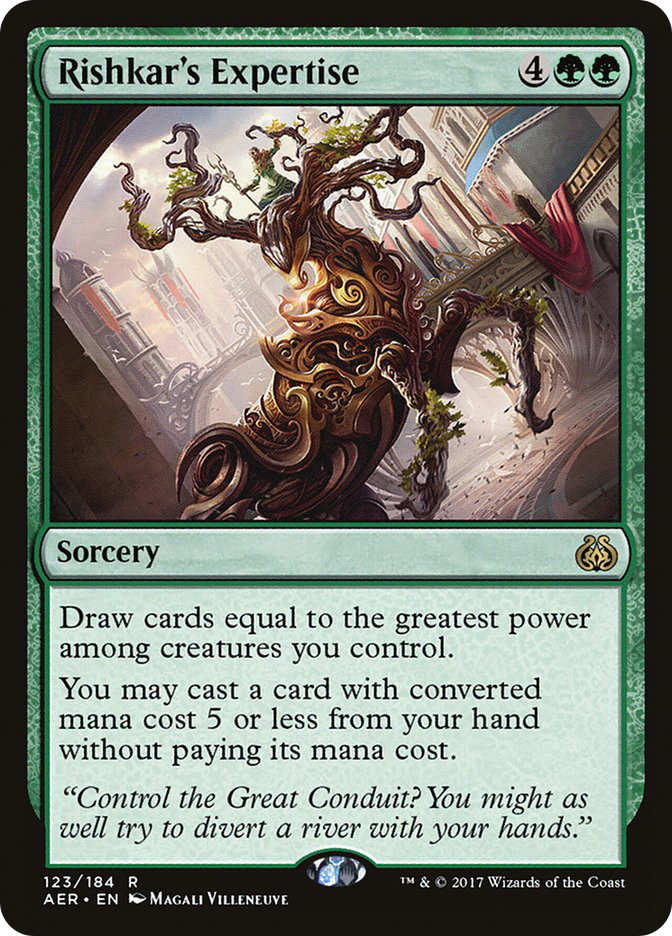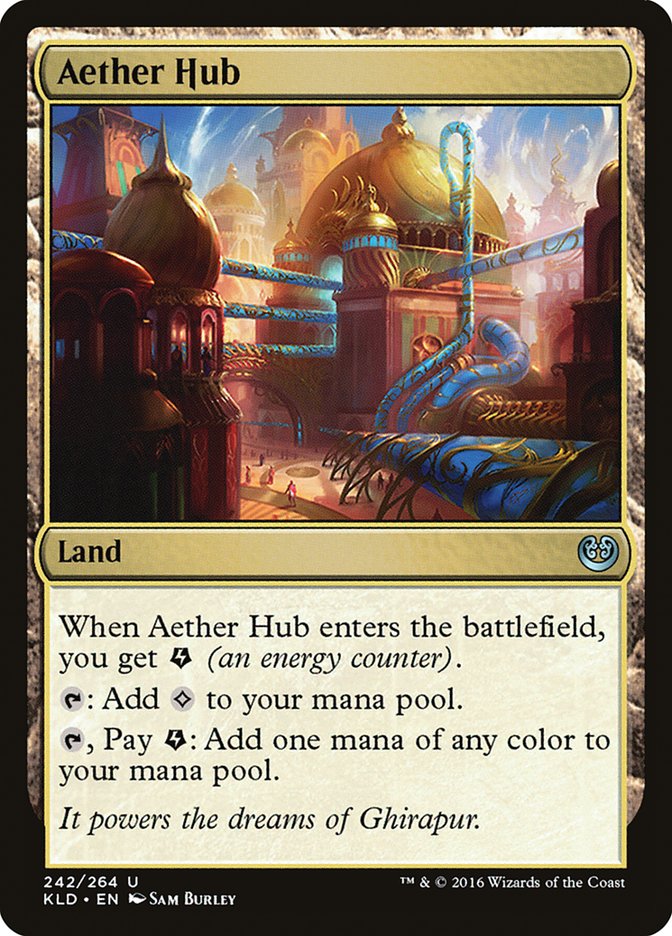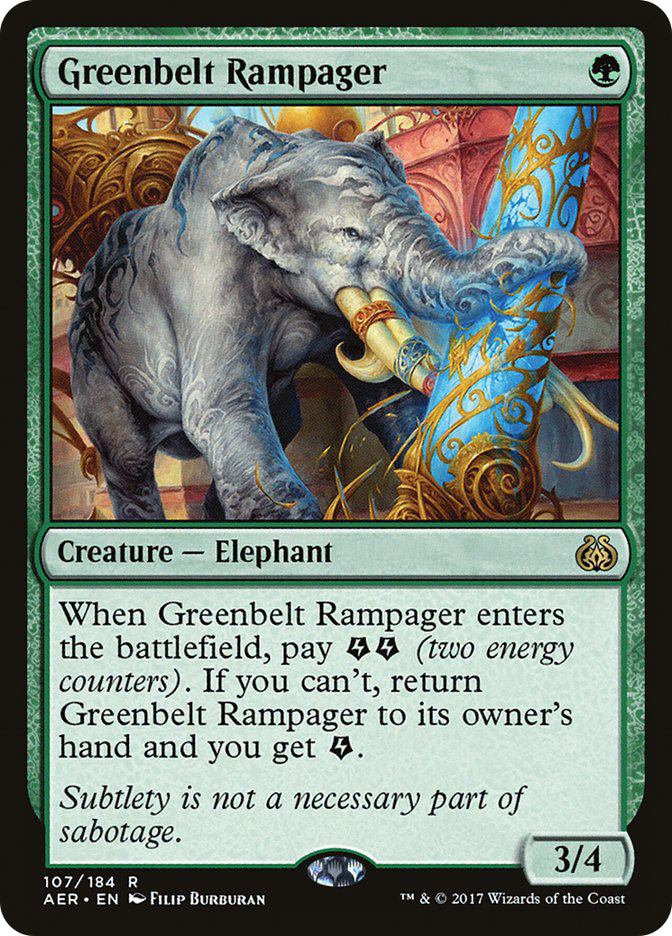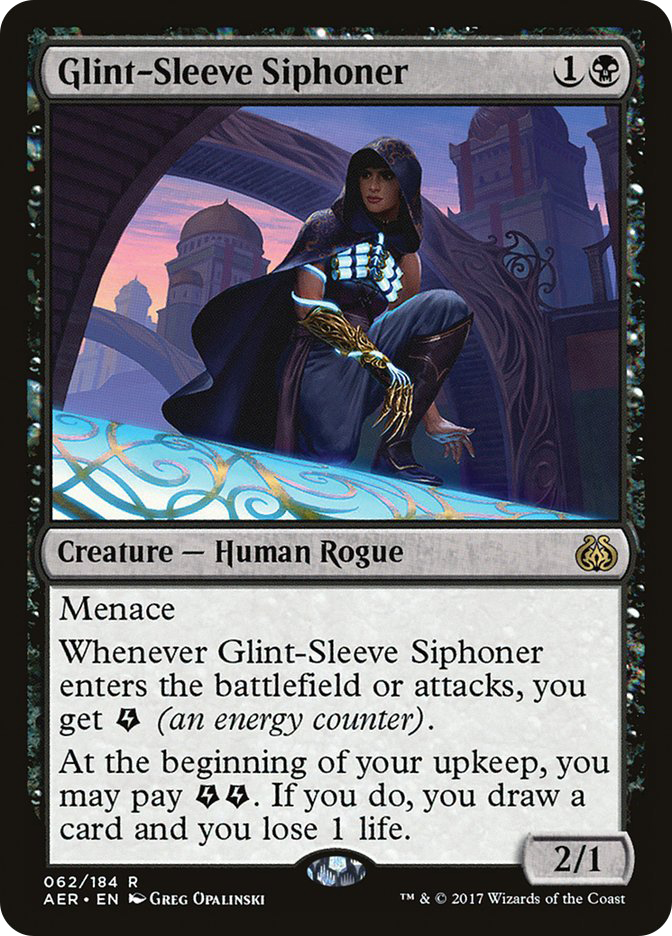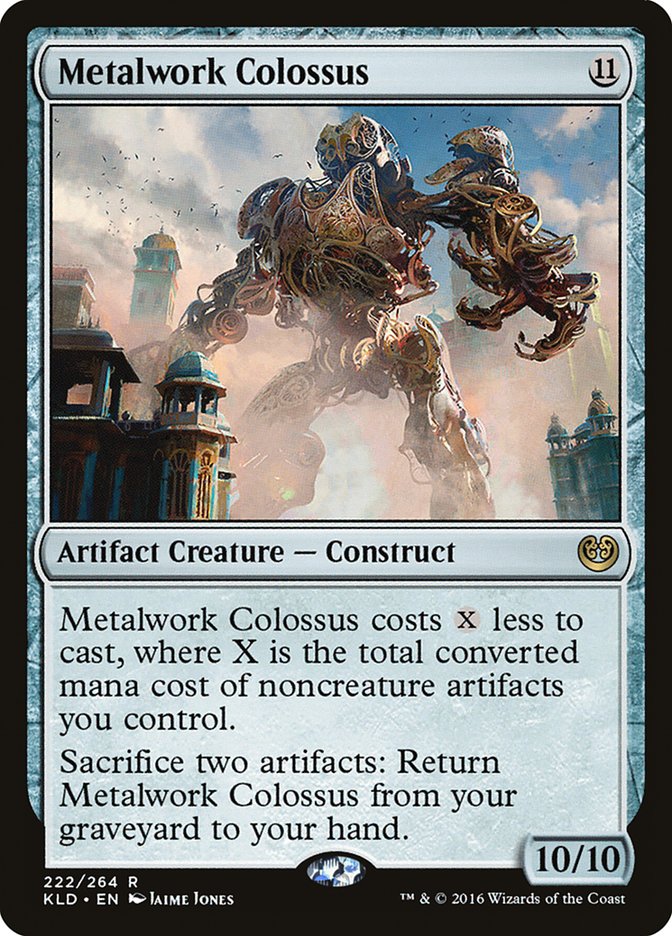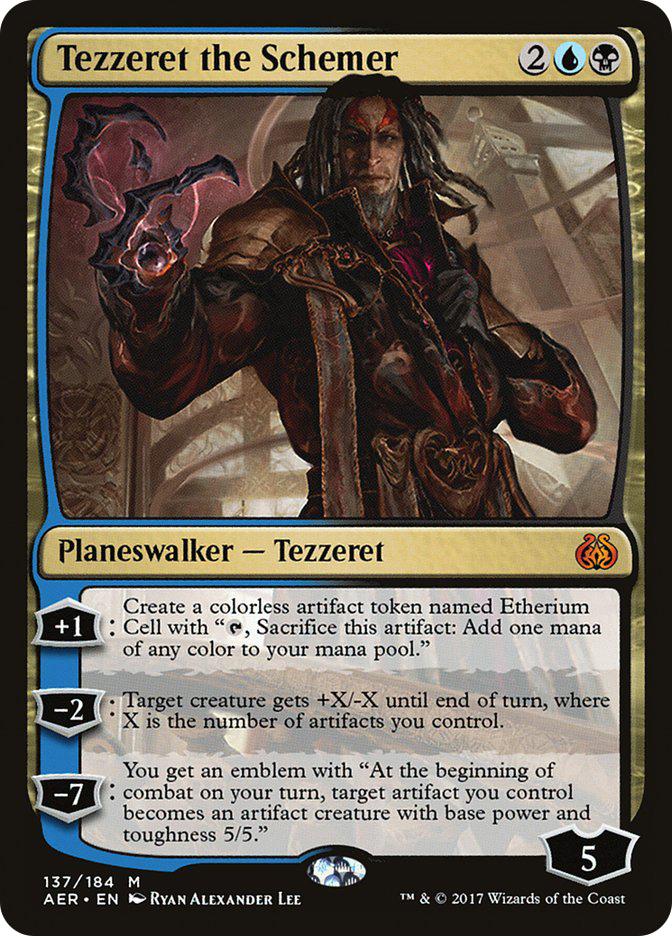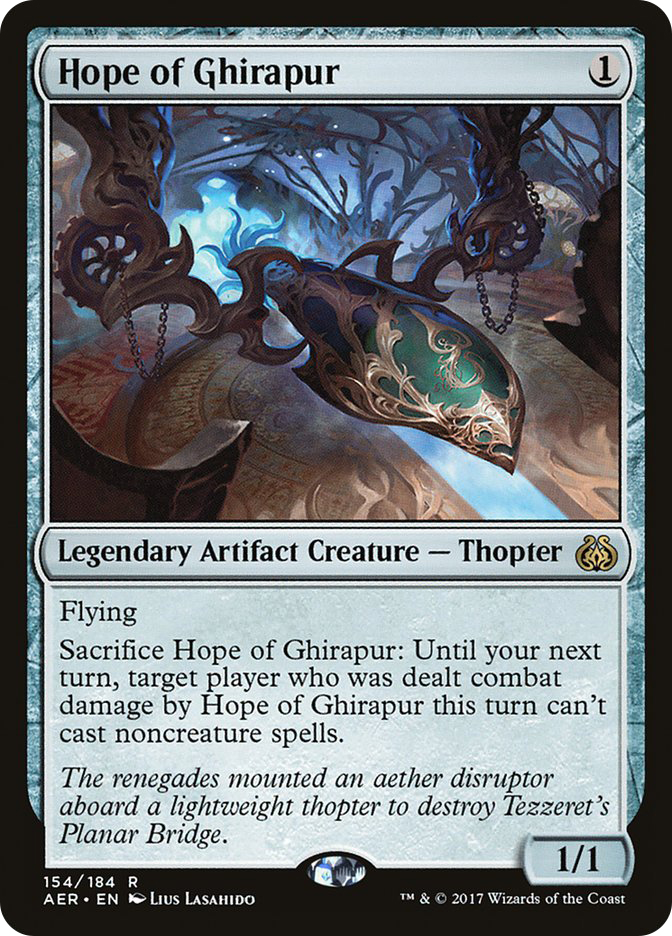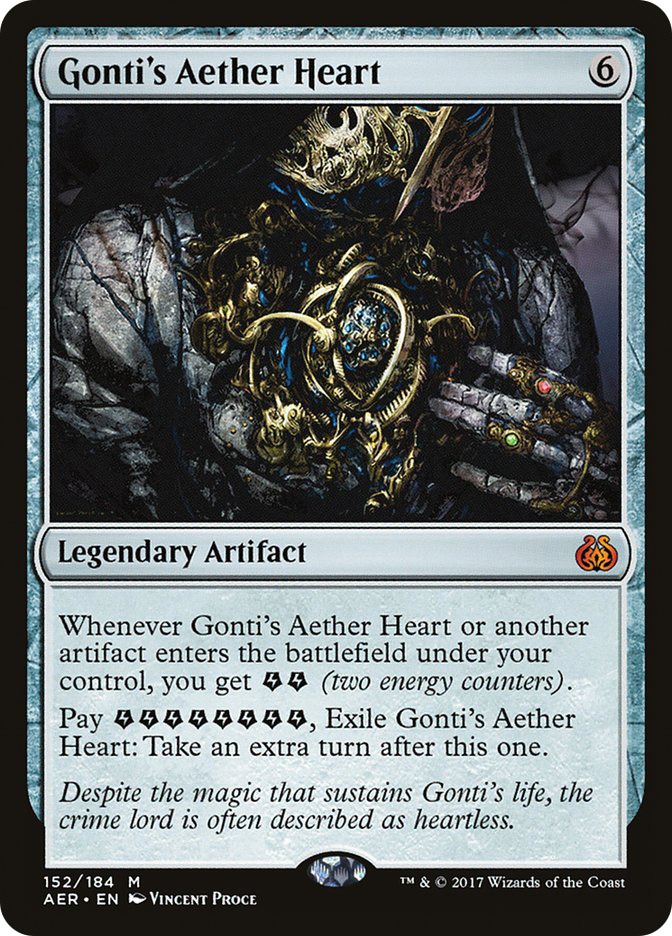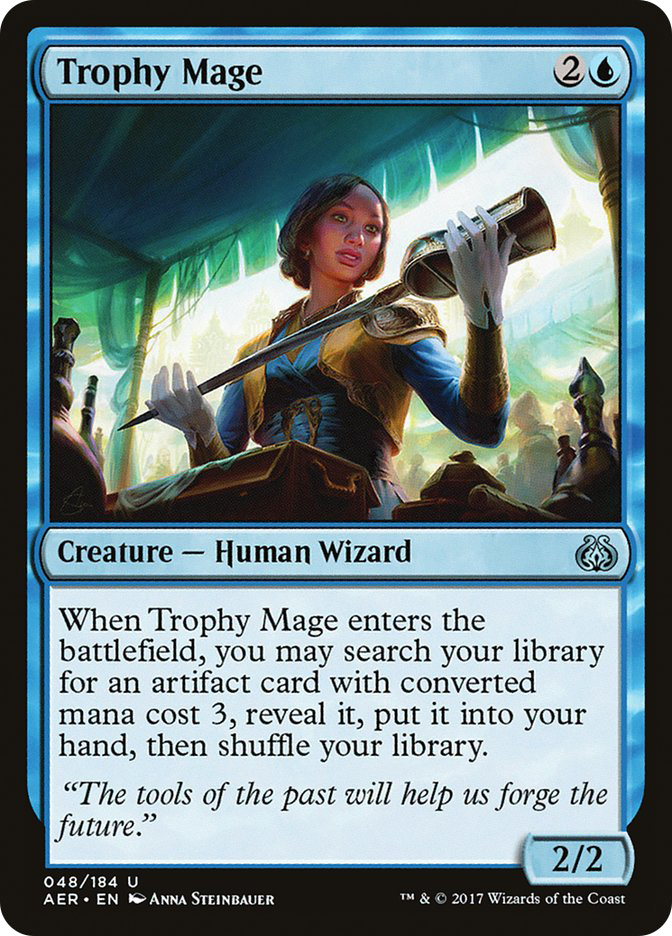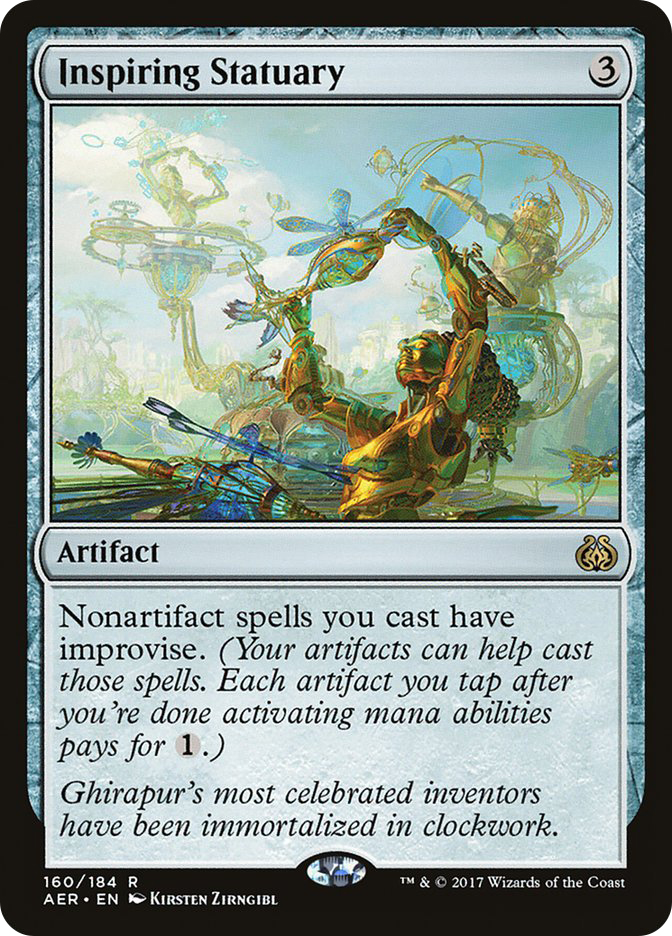I wasn’t expecting the full card list for Aether Revolt to be revealed until yesterday. I’m pretty bad at keeping track of the history of these kinds of things and it seems to change every few years or so, but I was still surprised (not to mention excited) when I hopped into Brad Nelson’s car on Friday afternoon to head to #GPLouisville, only to find him and Roanoke’s resident dizzler, Brian Braun-Duin, buried in their phones looking at a complete list of new cards.
The Grand Prix did not go well for yours truly, but that only gave me more time to mull over the new set and start looking at what exactly is possible now that the entirety of Kaladesh block and its synergies are available.
As it often happens, the fall set tends to be a disappointment because the new mechanics are fighting an uphill battle with one set against the full power of the previous blocks. Aetherworks Marvel was the lone exception in this regard, and even that was ultimately supported by a healthy dose of delirium from Shadows over Innistrad and Eldritch Moon.
But now the blocks are all competing on equal footing, and it’s easy to overlook previous failed ideas before seeing just how much the new decks improve relative to the old. So today I’ll be focusing on decks that exploit the synergies and mechanics of Kaladesh block, pushing them as far as they can go to see if they can compete against the established stars of Standard.
It’s an anxious time for all of us, so I’ll just get right to it.
My Kingdom for a Hardened Scales
+1/+1 counters are all over Kaladesh block and Aether Revolt offers some promising new tools for decks that want to utilize this mechanic. You’ll recall that I was pretty high on a certainsuperchargedfive–drop during Kaladesh preview season, and while Verdurous Gearhulk made some waves in Standard, it was certainly outshined by Smuggler’s Copter and Aetherworks Marvel. (Ban update: Well, not Smuggler’s Copter anymore!)
For the most part it saw play in aggressive Delirium decks, notably at the Season Three Invitational last month by Adam Snook and by Brad Nelson and Todd Anderson in the Standard portion of the Players‘ Championship. These decks used Verdurous Gearhulk as a powerful card in its own right, but they were firmly entrenched in the synergies of previous blocks. I want to build around Verdurous Gearhulk with Kaladesh block cards to get the absolute most out of it I can.
There are two cards that I think can help accomplish that. The first is Winding Constrictor.
I’ll keep my kingdom, thanks; I have a Hardened Scales right here. It may cost an extra mana, but it comes with a fine body to accept +1/+1 counters from Verdurous Gearhulk or Nissa, Voice of Zendikar. And it had better be ready to accept a lot of counters, because this Snake supercharges these synergies to absurd levels. Nissa, Voice of Zendikar now -2s to put two +1/+1 counters on all your creatures and Verdurous Gearhulk spreads anywhere from five to eight counters around, depending on how evenly you want to disperse them.
Any good curve with these cards is going to dominate the battlefield, often winning the game by turn 5 if unabated. But wait, there’s more! Rishkar, Peema Renegade is, like Verdurous Gearhulk, a powerful card in its own right that plays perfectly with the other pieces of the deck. It fills a valuable slot in the curve, and when paired with Winding Constrictor, you can have eight power on the battlefield on turn 3 with the potential to make up to six mana on the following turn. In combination with Nissa, Voice of Zendikar, you may be able to make the card free by turning on enough 1/2 Plant tokens you have lying around.
I don’t want to putz around trying to assemble delirium so my cards work. I want to get them dead. A list:
Creatures (25)
- 4 Verdurous Gearhulk
- 4 Scrapheap Scrounger
- 4 Servant of the Conduit
- 4 Winding Constrictor
- 3 Rishkar, Peema Renegade
- 2 Walking Ballista
- 4 Narnam Renegade
Planeswalkers (4)
Lands (18)
Spells (13)

No Traverse the Ulvenwald. No Grim Flayer. No Dead Weight for additional card types. Just the most efficient removal spells paired with a great curve of synergistic creatures. The one real concession I made in individual card power is Narnam Renegade, because this deck really wants a one-drop so it can maximize its best draws and the Renegade is better than Gnarlwood Dryad when you’re unlikely to achieve delirium. I’m not expecting to trigger Revolt with it very often, but I am expecting it to become a 3/4 or larger with regularity.
Look at what this deck can do when it curves out:
Turn 1: Narnam Renegade.
Turn 2: Winding Constrictor.
Turn 3: Rishkar, Peema Renegade, targeting your first two creatures.
Turn 4: Tap Winding Constrictor for G to cast Verdurous Gearhulk, targeting each of your creatures.
The end result is a 5/6 deathtouch, a 6/7, a 4/4, and a 6/6 trample. On turn 4. Even without the Narnam Renegade on turn 1, you have a great start. The rest of the deck includes Scrapheap Scrounger, Servant of the Conduit, and Nissa, Voice of Zendikar, all Standard staples, and some of the best removal in the format in Fatal Push and Grasp of Darkness.
The last synergy piece is Walking Ballista, which is inefficient on raw numbers but gives the deck a late-game mana sink, a way to answer hordes of Servo tokens when paired with cards like Nissa, Voice of Zendikar and Rishkar, Peema Renegade. It also turns Verdurous Gearhulk into a virtual Nekretaal if you want it to be.
It may seem like a simple aggro deck, but this list has a lot more going for it. It has the option to build onto one big threat or go wide with multiples. It also varies its threats between efficient creatures, sticky creatures, and planeswalkers to keep control decks off-balance. It manages to build great synergies with cards that are still powerful by themselves, so you’re not dependent on everything going smoothly and can put up a fight through significant resistance.
The one sideboard card I think deserves some attention is Rishkar’s Expertise. This effect has been printed several times before to little fanfare (think Shamanic Revelation and the like) because it’s too significant a tempo sink. The newest iteration solves that issue by letting you cast a big spell, likely one you draw off it, to recoup that tempo, which makes me think the card is ready to see some play. You can draw a pile of cards with it after casting a Verdurous Gearhulk, but I imagine it being cast for three or four cards, digging for the Gearhulk to cast for free afterward more often. It’s certainly a strong play with any Rishkar, Peema Renegade curve that ramps you to six mana on turn 4.
It may seem strange to see Aether Hub in the manabase, but with Servant of the Conduit, I like having another two-color land to help cast Grasp of Darkness, and Winding Constrictor acts as an energy source as well as one for +1/+1 counters. My initial lists of this deck tried to balance those two aspects of the card together before I realized there were enough tools to simply build two decks, each pushed toward one side. The energy-based list looks like this:
Creatures (25)
- 4 Verdurous Gearhulk
- 4 Longtusk Cub
- 2 Bristling Hydra
- 4 Servant of the Conduit
- 3 Greenbelt Rampager
- 4 Winding Constrictor
- 4 Glint-Sleeve Siphoner
Lands (15)
Spells (20)

The most powerful, and thus most important, interaction here is that between Winding Constrictor and Longtusk Cub. Winding Constrictor both gives you a lot more energy to sink into the Longtusk Cub and increases the efficiency with which that energy pumps the kitty. Now you trade two energy for two counters, which makes Longtusk Cub gigantic very quickly. Consider the following opening:
Turn 1: Attune with Aether.
Turn 2: Longtusk Cub.
Turn 3: Winding Constrictor.
Now you can make the Cub a 4/4, attack, and get three more energy if it connects, letting you turn it into a 6/6. If you play the Attune after Winding Constrictor or have an Aether Hub somewhere in the sequence, you can turn Longtusk Cub into an 8/8 on turn 3. Not bad for a pair of two mana-cards and a glorified land.
Greenbelt Rampager comes in here as either a cheap creature to double spell with on the early turns, or a constant source of energy. You can sink all you have into Longtusk Cub or Bristling Hydra and then cast Greenbelt Rampager when you can no longer pay for it. Rinse, lather, repeat, and your Greenbelt Rampager becomes a mana sink, letting you trade a green mana for an energy, or two energy if you have Winding Constrictor.
The other interaction to note is with Glint-Sleeve Siphoner. This is the best “fixed Dark Confidant” yet, even if it only draws a card every other turn by itself. But with Winding Constrictor, each attack nets two energy, enough to draw a card every turn. Even if you’re unable to attack, your other energy sources will yield enough to keep the cards flowing, and of course more cards means more energy: a self-perpetuating cycle, thermodynamics be damned.
However, having so much invested in these two-drops in a format with Fatal Push could prove to be the deck’s undoing, hence the inclusion of Blossoming Defense. The fourth isn’t out of the question, given how Longtusk Cub and Glint-Sleeve Siphoner snowball so quickly, but I don’t want to flood on them or be short on removal.
Fatal Push demands some slots even with no obvious ways to turn on Revolt, and Die Young is close to a sorcery-speed Murder in this deck. Both let you clear out blockers on the cheap so your gigantic Longtusk Cub can connect. Should your opponent have more blockers than you can remove, say, with Ishkanah, Grafwidow, Key to the City is there to get it through in the post-sideboard games.
Verdurous Gearhulk remains in this version of the deck mainly because its rate is so high and its synergy with Winding Constrictor so powerful, but it’s also another way to let your Longtusk Cubs and Glint-Sleeve Siphoners attack with impunity, thereby jumpstarting your energy production should you run out.
These decks do a good job of showing the potential that Kaladesh block has to shake up Standard, and you all know how much I like to attack, but at its heart Kaladesh is an artifact-centric block, so I would be remiss if I didn’t explore that avenue.
Are You Going to Inventors’ Fair?
Metalwork Colossus has been something of a pet card for Michael Majors this season, and sure enough, he featured an updated deck in hislastarticle. What I found curious was his desire to move the deck in a more controlling direction.
Tezzeret is a nice option, so I see the appeal, but with another set of artifacts and other tools, I want to see if the more combo-esque version of the deck can work.
In testing the deck last season, my primary issue with it was that you had to pass the turn after you cast a Metalwork Colossus or two, hoping your opponent doesn’t have an answer. In this way, the deck was more ramp than pure combo. I want to limit my opponent’s ability to interact on that key turn and put the game away before they can recover.
There are two cards from Aether Revolt that can fill this role. The first, Hope of Ghirapur, stops any big sweepers from undoing all your hard work. It’s a weak individual card, so you don’t want to flood on them, but the first copy does a lot of good work. Your opponent can pass the turn and use instant-speed removal on your Metalwork Colossi, but with Sanctum of Ugin you should have two, maybe even three, and post-sideboard, you can untap with a counterspell or two to lock up the game.
The second is Gonti’s Aether Heart, which simply lets you take an extra turn and end the game before your opponent untaps. It has the bonus of being a giant noncreature artifact to make Metalwork Colossus cheap. Ideally you want it to be free so you can cast two or three to get the energy necessary to Time Walk, so even if it takes until turn 6 or 7 to set everything up, you won’t have to play defensively because you’re well behind and need to pass the turn.
With those two, I think you can build a combo-focused Metalwork Colossus list:
Creatures (20)
- 1 Elder Deep-Fiend
- 4 Glint-Nest Crane
- 2 Scrapheap Scrounger
- 4 Metalwork Colossus
- 4 Foundry Inspector
- 3 Trophy Mage
- 2 Hope of Ghirapur
Lands (20)
Spells (20)

In addition to the Time Walk effects, this deck has Key to the City and Elder Deep-Fiend to remove blockers for a large attack. The latter is simply a tutor target for Sanctum of Ugin, so you don’t need more than one copy, which is great for a deck that needs a high density of artifacts.
Trophy Mage is the other significant addition from Aether Revolt, giving you consistent access to Cultivator’s Caravan while allowing for a small toolbox with Deadlock Trap and Aethersphere Harvester. Notably, those are both energy sources so you can tutor for them if you need more energy for Gonti’s Aether Heart but mostly they are defensive measures against aggressive decks and a good way to pressure opposing planeswalkers while you set up.
I initially tried to utilize Inspiring Statuary, but with the deck’s density of artifacts, you’re unable to leverage the powerful new mana rock effectively. Cultivator’s Caravan puts in good work both mana fixing and getting into combat in addition to ramping, making it better for the deck in that slot. It’s also the reason I chose Foundry Inspector over Herald of Kozilek, since the former can crew a Caravan by itself.
As is, I imagine this deck will struggle with aggro in Game 1 because of its lack of defensive measures but I want to start with the most pushed linear version of the deck. The Kozilek’s Returns and Skysovereign, Consul Flagships in the sideboard can work their way into the maindeck in some numbers to help out those matchups if need be.
You can toy around with this deck a lot because the addition of Spire of Industry gives the deck sixteen sources of any color of mana, allowing for a lot of light splashes. I’m only using Scrapheap Scrounger here, but perhaps Tezzeret the Schemer or something like Unlicensed Disintegration could be useful. It’s going to be important to scour the entire format because almost no card is off-limits here.
When Kaladesh was revealed, I was excited to see what the myriad interesting cards in the set could do, and after three months of W/U Flash, B/G Delirium, and Aetherworks Marvel, I think we’re finally going to get to a place where these cards can shine. The only question is which ones will rise to the top.



